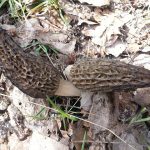Introduction
The Morchella genus encompasses a group of fungi renowned for their distinctive appearance and culinary allure. Morels, as they are commonly known, are cherished for their unique honeycomb-like caps and exquisite flavor. Beyond their culinary appeal, Morels have garnered attention in various scientific and biotechnological domains due to their intriguing life cycle, ecological roles, and potential applications.
Morchella Species: A Tapestry of Diversity
The Morchella genus comprises several species, each exhibiting subtle variations in morphology and ecological preferences. Some notable Morel species include:
- Morchella esculenta (Common Morel):
- Recognized for its cone-shaped, deeply pitted cap.
- Highly prized in gourmet cuisine for its earthy, nutty flavor.
- Commonly found in temperate regions, often associated with deciduous trees.
- Morchella elata (Black Morel):
- Distinguished by its dark color and elongated, conical cap.
- Grows in association with coniferous trees and in burned areas.
- Notable for its robust flavor and culinary versatility.
- Morchella deliciosa (Early Morel):
- Characterized by a pale, yellow to cream-colored cap with a honeycomb pattern.
- Appears in early spring and is a sought-after delicacy.
- Often found in association with ash, elm, and apple trees.
- Morchella rufobrunnea (Blushing Morel):
- Features a reddish-brown cap and a unique color-changing ability.
- Thrives in woodland habitats, particularly under hardwoods.
- Adds a mild, sweet taste to dishes.
- Morchella crassipes (Thick-footed Morel):
- Known for its robust stem and large, deeply pitted cap.
- Grows in a variety of habitats, including woodlands and grassy areas.
- Exhibits a rich, complex flavor.
Biotechnological Significance
The Morel genus, Morchella, holds promise in various biotechnological applications due to its unique biological attributes.
- Mycorrhizal Symbiosis:
- Morels engage in mycorrhizal symbiosis with trees, forming mutually beneficial relationships.
- The fungal mycelium assists trees in nutrient uptake, while the trees provide carbohydrates to the Morels.
- This symbiotic relationship is vital for forest ecosystems and contributes to soil health.
- Bioremediation:
- Morels have shown remarkable capabilities in bioremediation, particularly in environments contaminated with heavy metals.
- The mycelium of Morchella species can absorb and concentrate metals, offering a potential solution for soil and water purification.
- Culinary and Medicinal Applications:
- While primarily recognized for their culinary value, Morels contain bioactive compounds with potential medicinal benefits.
- Studies have suggested antioxidant and anti-inflammatory properties in certain Morel species, opening avenues for pharmaceutical applications.
- Cultivation and Commercial Production:
- The cultivation of Morels has gained prominence as a commercially viable venture.
- Controlled environment cultivation allows for year-round production, reducing reliance on wild harvesting and promoting sustainable practices.
- Nutritional Content:
- Morels are a rich source of protein, fiber, and essential minerals.
- The nutritional profile, coupled with their unique taste, positions Morels as a valuable addition to a well-balanced diet.
Cultivation Techniques and Challenges
Cultivating Morels presents unique challenges due to their complex life cycle and specific environmental requirements. Researchers and cultivators are actively exploring techniques to overcome these challenges and enhance production.
- Substrate Selection:
- Morels are known to have specific substrate preferences, often favoring organic matter associated with trees.
- Successful cultivation often involves mimicking these natural conditions using substrates like wood chips, peat, and agricultural residues.
- Environmental Conditions:
- Temperature, humidity, and light conditions play crucial roles in Morel cultivation.
- Controlled environments, such as indoor cultivation facilities, allow for the manipulation of these factors to optimize growth.
- Mycelium Expansion:
- Mycelium expansion is a critical phase in Morel cultivation.
- Innovations in mycelium propagation techniques contribute to efficient and scalable production.
Future Prospects
The Morchella genus continues to captivate researchers, mycologists, and entrepreneurs alike. Ongoing studies aim to unravel the genetic and biochemical intricacies of Morels, providing insights into their ecological roles and potential applications.
- Genetic Studies:
- Advances in genetic research shed light on the molecular mechanisms underlying Morel development and symbiotic relationships.
- Understanding the genetic basis of Morel traits facilitates targeted breeding for desired characteristics.
- Biotechnological Innovations:
- Biotechnological advancements, including genetic modification and synthetic biology, offer new possibilities for enhancing Morel cultivation and optimizing desirable traits.
- These innovations may contribute to increased yields, improved resistance to pests and diseases, and expanded applications in various industries.
- Sustainable Agriculture:
- Morel cultivation aligns with the principles of sustainable agriculture and conservation.
- The development of eco-friendly cultivation practices and the integration of Morels into agroforestry systems promote ecological balance and biodiversity.
Summary
In conclusion, the Morchella genus, encompassing the enigmatic Morels, stands as a symbol of both culinary delight and scientific fascination. From their intricate mycorrhizal relationships to their potential in bioremediation and pharmaceutical applications, Morels continue to unveil their secrets. As research and cultivation techniques progress, the Morchella genus holds promise for sustainable agriculture, environmental remediation, and the advancement of biotechnological innovation. The allure of Morels extends beyond the kitchen, inviting exploration into the intricate world of fungal biology and its practical applications in our evolving world.
Related Posts
- Exploring the Pleurotus Genus: Diversity, Characteristics, and Biotechnological Marvels
The Pleurotus genus, commonly known as oyster mushrooms, represents a fascinating group of fungi with…
- The Streptococcus Genus: Pioneers in Microbial Diversity and Medical Significance
The Streptococcus genus stands as a testament to the remarkable diversity and complexity within the…
-
Morchella Angusticeps
Morchella angusticepes Peck (M. angusticepes Peck) is a very interesting fungus as well as being a…

Leave a Reply